- Region
- Águilas
- Alhama de Murcia
- Jumilla
- Lorca
- Los Alcázares
- Mazarrón
- San Javier
-
ALL AREAS & TOWNS
- AREAS
- SOUTH WEST
- MAR MENOR
- MURCIA CITY & CENTRAL
- NORTH & NORTH WEST
- TOWNS
- Abanilla
- Abarán
- Aguilas
- Alamillo
- Alcantarilla
- Aledo
- Alhama de Murcia
- Archena
- Balsicas
- Blanca
- Bolnuevo
- Bullas
- Cañadas del Romero
- Cabo de Palos
- Calasparra
- Camping Bolnuevo
- Campo De Ricote
- Camposol
- Canada De La Lena
- Caravaca de la Cruz
- Cartagena
- Cehegin
- Ceuti
- Cieza
- Condado de Alhama
- Corvera
- Costa Cálida
- Cuevas De Almanzora
- Cuevas de Reyllo
- El Carmoli
- El Mojon
- El Molino (Puerto Lumbreras)
- El Pareton / Cantareros
- El Raso
- El Valle Golf Resort
- Fortuna
- Fuente Alamo
- Hacienda del Alamo Golf Resort
- Hacienda Riquelme Golf Resort
- Isla Plana
- Islas Menores & Mar de Cristal
- Jumilla
- La Azohia
- La Charca
- La Manga Club
- La Manga del Mar Menor
- La Pinilla
- La Puebla
- La Torre
- La Torre Golf Resort
- La Unión
- Las Palas
- Las Ramblas
- Las Ramblas Golf
- Las Torres de Cotillas
- Leiva
- Librilla
- Lo Pagan
- Lo Santiago
- Lorca
- Lorquí
- Los Alcázares
- Los Balcones
- Los Belones
- Los Canovas
- Los Nietos
- Los Perez (Tallante)
- Los Urrutias
- Los Ventorrillos
- Mar De Cristal
- Mar Menor
- Mar Menor Golf Resort
- Mazarrón
- Mazarrón Country Club
- Molina de Segura
- Moratalla
- Mula
- Murcia City
- Murcia Property
- Pareton
- Peraleja Golf Resort
- Perin
- Pilar de la Horadada
- Pinar de Campoverde
- Pinoso
- Playa Honda
- Playa Honda / Playa Paraíso
- Pliego
- Portmán
- Pozo Estrecho
- Puerto de Mazarrón
- Puerto Lumbreras
- Puntas De Calnegre
- Region of Murcia
- Ricote
- Roda Golf Resort
- Roldan
- Roldan and Lo Ferro
- San Javier
- San Pedro del Pinatar
- Santiago de la Ribera
- Sierra Espuña
- Sucina
- Tallante
- Terrazas de la Torre Golf Resort
- Torre Pacheco
- Totana
- What's On Weekly Bulletin
- Yecla


- EDITIONS:
 Spanish News Today
Spanish News Today
 Alicante Today
Alicante Today
 Andalucia Today
Andalucia Today
Murcia Today Weekly Bulletin 23rd January
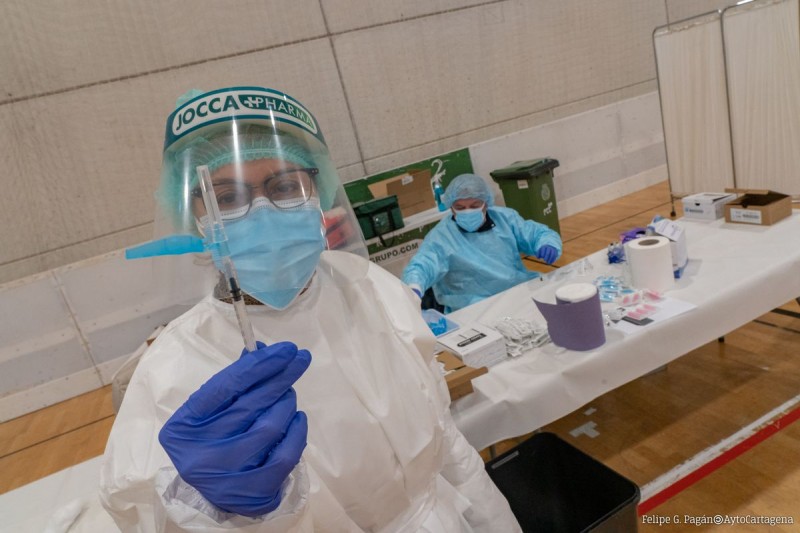
Image: Vaccination of SMS workers in Cartagena this week.
This week the coronavirus pandemic has continued to dominate the news, as Spain pays the price for seasonal socialising.
The week began on Monday with Spain reporting the highest number of cases diagnosed over a weekend since the pandemic first began; 84,000.
The number of new infections remained high all week with the record for new cases broken three times in four days as figures in excess of 40,000 new cases a day easily beat the previous record high; 25,595 positives on October 30th. So it’s no surprise that a record level of the accumulated incidence rate at 828 cases per 100,000 inhabitants was reached on Friday afternoon.
It was a record week for all the wrong reasons, as by Friday the weekly total of new cases had risen by almost a quarter of a million in 7 days; 247,396, 11% higher than the previous week.
And the number of fatalities were high; 2,127 in the last 7 days, rising from 53,314 last Friday to 55,441 this Friday.
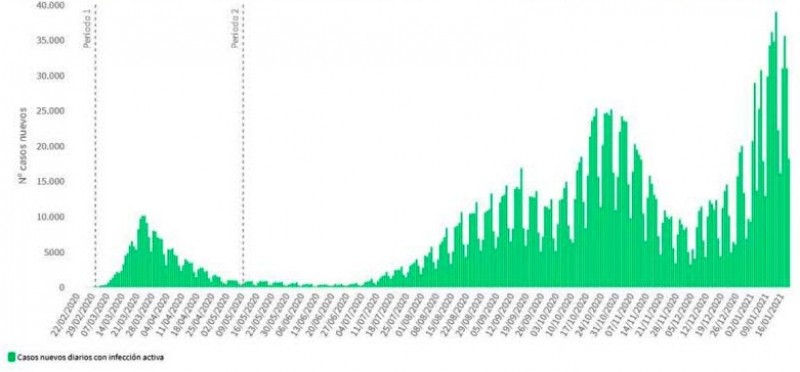
Image: number of new cases in Spain
Situation in hospitals:
It’s unavoidable that hospitals should be facing significant pressure when this level of new diagnoses is reached and in the last 7 days, 7,174 people have been admitted for Covid in Spanish hospitals, bringing the total number requiring treatment for more severe cases of coronavirus to 27,462, an increase of 39.7% compared to last week.
The total level of bed occupancy by Covid patients is 21.6%, but the level in intensive care is higher; 37%, and the 3,908 intensive care unit patients are 32% higher this Friday than last Friday.
But this is the national average and in some areas the pressure is more intense; in La Rioja, this percentage is already 65%, it’s 58% in the Valencian Community, 52% in Melilla and close to 50% in Castilla-la Mancha, Catalonia and Madrid. The maximum risk threshold set by the Health Ministry for ICU occupancy is 25%: only Asturias, Cantabria, Canarias, Ceuta Galicia and Navarra are below this level, although in all areas of the country hospitals are now starting to really feel the pressure.
Although the epidemic can now be said to be rampaging away in most regions of Spain, the situation in six regions is particularly worrying; Castilla-la Mancha, Castilla y León, Extremadura, Valencian Community, Murcia and La Rioja where the incidence rate exceeds 1,000 cases per 100,000 inhabitants; Extremadura, 1,448 cases, Castilla-La Mancha (1,158), Castilla y León (1,215), Valencian Community (1,245), Murcia (1,333) and La Rioja (1,208).
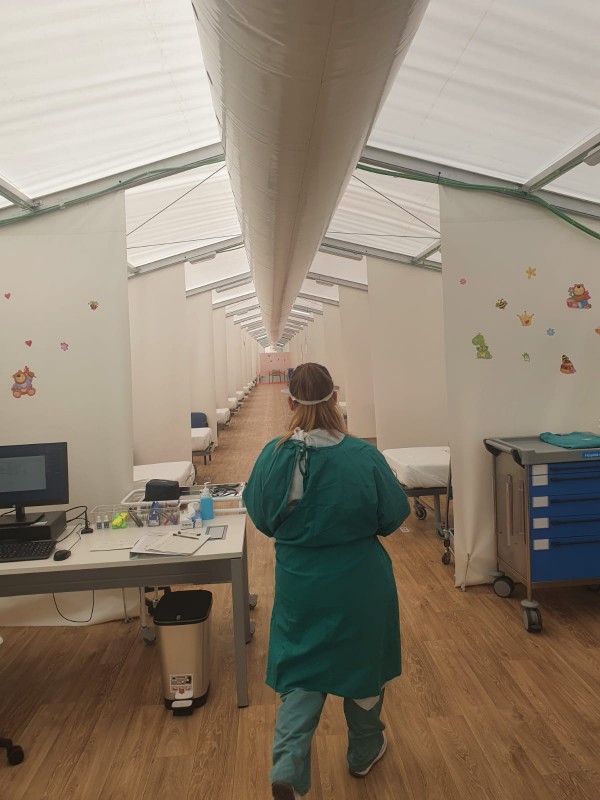
The Region of Valencia, which has experienced one of the sharpest rises in cases recently, has opened three field hospitals to help it cope with the additional patients, one of them in Alicante and throughout the week has watched its numbers of new cases and deaths reach record levels.
Spain and Portugal suffering the worst third waves of the pandemic in Europe:In most of Europe the start of 2021 has heralded a gradual decrease in coronavirus incidence rates, but in Spain and Portugal the new year has been marked by continuing and significant increases.
Measuring the severity of the current pandemic situation in terms of the number of cases reported per million inhabitants per day, the worst affected country in Europe at present is reported to be Portugal at 1,025, followed by Sweden and Slovenia, but in the former the rate has dropped significantly in recent weeks and in the latter the figures have remained more or less stable since October, while Spain is ranked fourth with a rate of 733 after a dramatic increase over the course of the last three weeks.
Apart from the Iberian Peninsula the rest of the continent is reporting a gradual improvement in the success of measures to contain the pandemic, leaving Spain and Portugal as Europe’s current “hot spots”.
Although Europe continues to enforce new measures to control the spread of the virus (the Netherlands begins a strict curfew today, with lockdown at 9pm, Belgium has banned its residents from taking foreign holidays, Finland has tightened up on its arrivals rules, France has today said it will insist on a PCR test for anyone entering the country and even the UK is now discussing the possibility of foreign arrivals quarantining in hotel accommodation or closing borders altogether) the latest 14-day accumulated incidence rates published by the ECDC (only updated to Thursday) clearly show the "European hotspots"; Spain (804 cases per 100,000 inhabitants) Ireland (1,444), the Czech Republic (1,362), Portugal (1,215) and those which are performing better; Germany (319), Italy (374), France (380), Poland (305), Belgium (248)Denmark (364) Greece (79), Norway (148), Finland (61).
Response:
Murcia businesses producing 345,000 facemasks and PPE items every week: businesses have had to adapt their manufacturing businesses to produce products needed in the current marketplace.In the Region of Murcia alone as many as 225,000 facemasks and 120,000 medical and hospital gowns are now being produced every week, and the regional government has helped the companies responsible for them to obtain the official quality certifications required.
Curfew and restrictions:
Throughout the week a topic which has surfaced many times across Spain is that of the modification of the legislation (state of alarm) which permits the regional governments to apply measures in their respective regions to limit the spread of coronavirus.
At the moment, the national government has imposed some strict limits which must be complied with (ie curfews may not be implemented before 10pm in order to not restrict the liberty of citizens of Spain) but has fought shy of imposing total confinements as was the case in the spring, instead permitting the governments of the 17 regions to make most of their own decisions based on their own local situation.
Although the government has been accused of side-stepping the hard task of micro-managing the pandemic, the system has worked fairly up until now, but last week there was a growing swell of discontent as several regions were refused permission to either implement a total confinement (lockdown) or bring forward the hour of the curfew, following an “explosion” in the number of new cases since the seasonal break, which has intensified this week.
It all came to a head last weekend when the Government of Castilla y León basically defied the Government and brought forward its curfew to 8pm, in spite of being told that it couldn´t.
On Monday the Government set in motion legal processes to prevent this happening, but the mood of rebellion has been growing stronger all week and several regions have requested a revision of the state of alarm to give them the wider powers they want.
On Monday the regional president of Murcia, Fernando López Miras, sent a formal letter to the Prime Minister Pedro Sánchez formally requesting that the regional governments be permitted to enforce an earlier curfew and also be permitted to impose full lockdowns in specific areas, such as a specific municipality, in order to bring the virus under control.
Andalucía, which is one of the regions with the highest growth in cases, did the same.
On Monday Castilla la Mancha brought forward its existing curfew and intensified restrictions.
On Tuesday the Region of Valencia (Comunidad Valenciana which comprises the provinces of Alicante, Valencia and Castellón), also requested that the curfew be brought forward to 20:00, announced that it would be closing all bars and restaurants completely for 14 days and was bringing forward the closure time of its retail sector until 6pm in a bid to stem soaring contagions.On Friday the region amplified restrictions further to include a ban on any gatherings in the domestic environment outside of the immediate family unit.
Madrid; amplified confinement of 56 basic zones and 25 municipalities from Monday affecting 1.6 million people. Curfew modified to 22:00 to 06:00. All establishments must close by 21:00. A maximum of 4 people at a table in the hostelry sector. Social gatherings at home prohibited other than for the residents of a domestic bubble.
The Basque Country reduced the number of people permitted to meet socially to 4 and imposed a border confinement by municipality.
The Balearic Islands Government has ordered the confinement of the island of Ibiza under the same conditions as the confinement currently decreed in Formentera.
And there have been literally dozens more restrictions imposed this week, too many to list individually.
But in spite of all the pressure from the regional governments, the national Government has remained firm and resolutely refused to extend the curfew or permit total lockdowns, maintaining that the regions have sufficient tools at their disposal now with which to bring the pandemic under control without adopting these harsher restrictions. The Spanish government once again stood firm on Wednesday in refusing to bow to the pressure being exerted by regional administrations during the meeting between heads of all regional health authorities, even with 15 of the 17 Autonomous Communities requesting these additional measures and again on Friday the Prime Minister also refused to back down, the message stated time and time again this week that the regional governments do not need to impose a full lockdown to bring their figures under control.
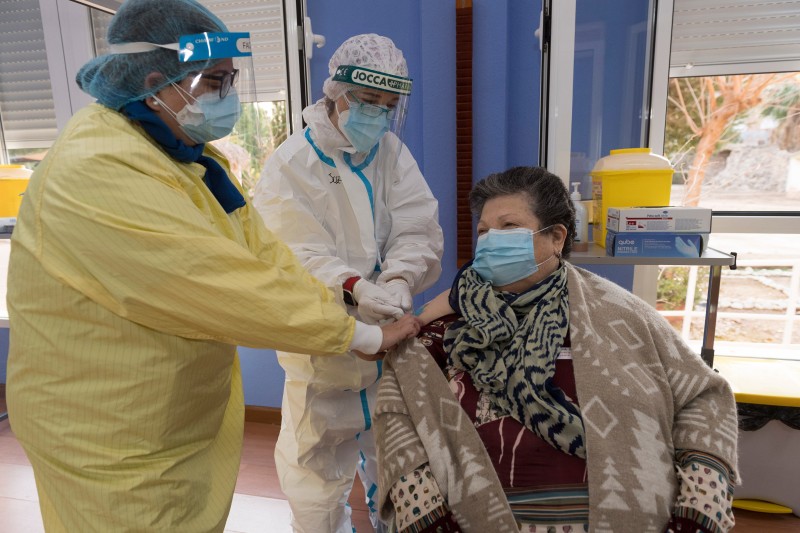
Vaccinations
According to the latest daily update published by the national government the number of vaccine doses so far administered in Spain has reached 1,165,825 and 68,456 patients have received their second dose.
The Spanish Government maintains that vaccinating and enforcing restrictions are the key to managing the pandemic, but is facing growing problems with its vaccine supply, along with much of Europe.
Although the UK is aiming to administer a first dose to as many people as possible and wait several weeks before administering a second dose, the Spanish authorities have decided to take the other route open to them and will complete the vaccination process with two doses, two weeks apart, as was originally planned.
This is logically slowing down the speed at which essential workers and those most at risk from the vaccine in their daily working lives are being vaccinated, and there is growing frustration at the slow roll-out of the vaccination programme in Spain.
Spain is amongst the European countries which form the EU bulk purchasing block and were told last week that Pfizer would be reducing the number of vaccines sent for the coming weeks whilst it adapts its manufacturing installations in order to be able to produce a larger number of doses more efficiently from the end of March onwards.
On Monday Spain received 44% less of the Pfizer vaccine than had originally been scheduled, only 205,727 instead of 350,000 and although this situation will rectify itself in the coming weeks, some areas have already run out of vaccines. In Madrid for example, vaccinations of health personnel have had to stop this week due to lack of supply.
The roll-out of the second dose of the Pfizer vaccination began on Sunday across Spain, including in Murcia, where care home occupants and care workers received a second dose of the Pfizer vaccine and the Moderna units received to date will be used to vaccinate health workers with a first dose.
However, today, AstraZeneca said a production problem meant the number of initial doses available for delivery to the EU would be lower than expected once their authorisatioin has been granted, which is imminent, and it is reported as being likely that initial deliveries to the EU will be temporarily reduced by up to 60%.
The EU Health Commissioner expressed "deep dissatisfaction" at the AstraZeneca delay, which will further frustrate the efforts of the Spanish Government (and other EU governments) to speed-up its vaccination programme.
Spain has several vaccination research projects of its own, but even the most advanced of these is not likely to bring a vaccination into production until 2022. First Spanish Covid vaccine achieves 100 per cent success rate in animal testing. The CSIC (the Spanish National Research Council) claims 100 per cent effectiveness rate in initial testing on animals of the vaccine they have developed.
Hampered by a low level of funding, scientific researchers in Spain have been slower than those in some other countries to develop their vaccines, but among them the CSIC project is the most advanced.
The vaccine is based on a variant of coronavirus which was used in the past to eradicate smallpox, and has proved fully effective in testing on mice, according to an article published in the Journal of Virology.
However, the Spanish vaccine is still a long way from being ready for use in the human population. The next step will be to obtain permission from the Spanish Medicines Agency to proceed with the first two phases of clinical testing on humans, the first on a sample size of just 100 and the second in larger groups. At this stage it is too early to predict when the Spanish vaccine might be ready for use in the general population, but even if the first phases run smoothly it is unlikely to be this year.
These delays are leading to significant criticism and dis-satisfaction and this week there has been considerable controversy and arguments about some members of the political hierarchy vaccinating themselves ahead of the schedule laid out by the Spanish government (and being accused of abuse of power).One of the casualties has been the Murcian regional health minister who was forced to resign after fierce criticism from opposition politicians for vaccinating not only himself, but also many high-profile figures within the Murcian Health Service, including the managerial head of the SMS.
The minister himself and over 400 staff of the main Murcian Health Service headquarters, had all been vaccinated against covid ahead of frontline workers, thus breaching the guidelines established by the national Ministry of Health prioritising the order in which vaccinations would be administered.
Although he has been an exemplary minister for the last three years, the decision to vaccinate office staff before frontline workers was widely viewed as a serious error in judgement, although he is not alone and across the country there have been dozens of cases coming to light of similar occurrences.
Although Sr. Villegas resigned, his counterpart in the enclave of Ceutí who was also vaccinated, refused to resign.
The Mayoress of Molina de Segura, also in the Region of Murcia, was removed from the PSOE party by the head of the regional PSOE after taking a vaccination, in spite of being "a high-risk cancer patient with a high social exposure". The Prime Minister called on Friday for any PSOE officials who had been vaccinated to step forward and resign from the party.
But there have been dozens of examples surfacing all week, ranging from priests who were visiting carehomes when there just happened to be a couple of vaccines left over, family members of those in carehomes who happened to be around at the right time, mayors from all parties, high-ranking police officers etc etc, and although there is certainly justification in some cases, there is also clear evidence of abusing the system in others. A lot of the conflict has come due to the interpretation of what exactly constitutes "health and social health personnel" as in the case of the former Murcian Minister who is also a doctor, so is entitled to a vaccine in phase one. He claimed that the personnel running the regional health service were also health and social health personnel, so were essential staff and entitled to a vaccine in phase 1, but until frontline workers, police, firemen and teachers have been vaccinated, many people in daily risk of contracting the virus through their work will not receive the protection they need.
Top priority in phase one are.
Residents and health and social health personnel who work in homes for the elderly
and care for dependents
2. Front-line personnel in the health and social health field
3. Other health and social health personnel
4. People considered highly dependent that are not currently institutionalized
5. The over 80’s
It is expected that vaccination in this first phase will conclude by the end of March.
Phases 2 and 3 include all those over 64, persons in conditions of risk which includes firemen, policemen etc, those working in enclosed spaces, those socially and economically vulnerable, essential sectors and educational sector, a period of vaccination scheduled to take until the end of June.
The final phase moves on to adults, juveniles, children etc from July onwards.
Realistically, given the current speed of the roll-out, pensioners over 65 can expect to receive their first jab from April onwards, and those who are older could possibly be vaccinated towards the middle/end of March, but before is unlikely as the Government is administering two doses of each vaccine within the recommended 2-3 weeks from the first vaccine, which will slow down the numbers vaccinated.
On Saturday the Murcian regional president appointed a new health minister; Juan José Pedreño, a family doctor from Lorca.
Second case of Spanish court ordering compulsory covid vaccination of carehome resident. It is under a week since the first case was reported in Spain of a judge ruling in favour of a patient compulsorily receiving the coronavirus vaccine and already a second instance has come to light, this time in the city of Sevilla.
The case concerns an 86-year-old woman living in a home for the elderly who is not in a fit condition to make rational decisions about vaccination on her own, and whose son refused to give his consent for her to receive the jab. The judge in Sevilla ruled against this opinion, publishing an order on 15th January in favour of the patient receiving the necessary doses from specialized healthcare staff as scheduled.While recognizing that there is no legal obligation for people to be vaccinated, the judge states that the issue has to be looked at from the point of view of protecting the woman’s health and that the risks inherent in receiving the vaccine far outweigh those involved in not receiving it.
The woman’s son had maintained repeatedly that vaccination is not completely safe and that he preferred to wait until more time passes and it becomes possible to evaluate potential side effects, an opinion the judge describes as “understandable and legitimate”: however, priority is given to the European Medicines Agency, which has authorized the use of the treatment. This mirrors the decision reported last week regarding another female resident of a home for the elderly in Santiago de Compostela, in the region of Galicia.

Lack of vaccine in europe could cause disruption in tourism sector
The lack of vaccines throughout Europe is set to cause disruption to the tourism sector in coming months, a logical side-effect of the fear being generated by the emergence and spread of more contagious and dangerous variants.
Last summer the economic pressure from the tourism sector to be allowed to re-open after the first lockdown undeniably contributed to the second and third waves now being experienced. It has been said many times since that being impatient and re-opening for business, thereby permitting widespread mobility before bringing contagions down lower was a mistake and our governments are painfully aware that their mounting death rates and short-term economic woes must be as carefully managed as the degree of restrictions they enforce and public expectation.
This was very well illustrated this week when the Prime Minister, Pedro Sánchez, told the World Tourism Organization that his top priority is to vaccinate the domestic population and prepare tourism for the future.
The President made it clear that although he is ready to work towards the recovery of the tourism sector, and views the tourism sector as an important sector for the country, providing 12% of GDP, that, “Tourism recovery begins with vaccination. And full recovery, with full vaccination. Total and massive ".
"Only massive vaccination can open the doorway to the pathway of normality that we all desire, " he said.
His words have been misquoted, as although the implication inherent in what he has said is that Spain must protect its own population first, the tourism sector must focus on building for the future and this year domestic tourism will necessarily be more important to the recovery of the economy than international tourism will be, due principally to the lack of international mobility caused by the coronavirus, he DIDN´T say that Spain would not be opening to foreign tourists or that foreign tourists would not be welcome, as was widely published in some online media sources, who all reproduced the text published by one source, which got it badly wrong.
The PM's office put out a statement that the PM was being misquoted on Friday, but not before the free press had re-published the erroneous information directly to foreign audiences, and social media had spread it all over the world.
The PM made the point in his speech that "the problem is not one of demand, but of mobility, " warning that although foreign tourists want to come to Spain, the continued spread of the virus may make it more difficult for them to do so.
Spain has insisted that those arriving in the country provide a PCR test and has currently banned British nationals, the largest market for Spain, from entering the country due to the "British variant" of Covid-19. Dozens of countries have mobility orders in place and the sector expects a complicated year due to the emergence of new variants, such as the "British variant", "the Brazilian variant" and the "South-American variant", all of which will make travel more difficult this year.
On Thursday the EU agreed to try and keep internal EU borders open to member states, but as we have already seen on Saturday, there is nothing stopping the Belgian Government from banning its residents from taking foreign holidays or the UK closing its borders, or Germany including Spain in its list of high-risk nations to which its citizens should not travel or France insisting that anyone entering its borders provide a negative PCR test.
There has been further talk this week about the possibility of "covid passports" being created, but there is also a sense that governments are changing their rhetoric to quash any hopes of a normal summer ahead and trying to condition their residents to accepting that the coronavirus crisis will be continuing for many months to come.
Meanwhile, airlines are doing the only thing open to them and cancelling flights. Ryanair has this week cancelled further flights to Corvera airport in Murcia, although the airport is NOT closing down as some social media users are claiming.
Variants:
On Sunday evening the Murcian Health Authority announced that 3 further cases of the British variant had been discovered in Murcia, bringing the total to 4.
On Monday the Madrid president asked the Spanish Government to suspend flights from South Africa and Brazil due to fears over these variants. She criticised the Government for acting "too slowly" in banning travel when the extent of the British variant was unveiled in the UK as Madrid now has the highest number of cases of this variant of any region in Spain. "A country that does not protect its borders does not protect its citizens," she said. Click to read
At the end of last week the Spanish Health Ministry announced that it would be carrying out a survey to try and establish the spread of various variants across Spain, and although the results have not been published, the Health Ministry suddenly changed its tune on Friday when Fernando Simón, the Director of the Coordination Centre for Health Alerts and Emergencies, moved his position from that adopted 10 days ago when his stance was that the impact of the variant in Spain was “marginal” to warning that by mid-March it could well account for between 40 and 50 per cent of all cases and will become the “dominant” strain in Spain.
At present the British variant is being detected in under 5 per cent of confirmed cases of Covid-19 in Spain. During the period before December when the restrictions on travel were less severe than is currently the case it is inevitable that the strain will have travelled from England to Spain, and in instances where detail has been given about the source of a contagion, it is almost always attributed to a British national travelling from the UK.
It must be highlighted that there was a period in December during which British residents were not banned from travelling and were only forced to supply a PCR test if entering Spain by air or through a Spanish port and an unknown number of British nationals seized the opportunity to drive to Spain without having to supply a PCR test and some of these individuals are now KNOWN to have tested positive (without naming names). All four of the cases detected in Murcia were British nationals and are known to have entered the region during December.
Sr. Simón’s estimate is based on applying the same timescale for the spread of the strain as was observed in the UK, where the variant was first detected in late September and was accounting for 40 per cent of infections by mid-December (as opposed to 4 per cent three months earlier).
As for ways in which the more virulent mutation of the virus can be combated, Fernando Simón repeats that the aim is not to invent new preventative measures but to apply and implement those which already exist. These include the closure of bars and restaurants, which has been seen to be effective in reducing transmission of Covid: as Sr Simón says, most people do not go to a bar to stand alone in a corner, and of course in order to eat and drink it is necessary for facemasks to be removed in a public place.
New variant could be more deadly after all
After several weeks denying that the "British variant" was any more deadly in spite of being more virulent, the British Prime Minister, Boris Johnson, made a statement on Friday afternoon to the effect that the "British variant" may be associated with a higher degree of mortality.
Mathematical analysis comparing the number of deaths attributed to the “old” strain of the virus compared to those of fatalities found to have been infected by the new “British variant” found that the fatality rate in those infected with the new variant was up to 30% higher.
The illustration given was that if the fatality average recorded amongst 1,000 60 year-old patients was 10 deaths, then the new variant would increase that average to 13, making the new variant potentially 30% more deadly.
It is believed that the new variant spreads between 30-70% faster although more research is yet to be done.
Up until Friday afternoon it was believed that the danger presented by the "British variant" lay in its transmissability; the number of contagions being higher, thus increasing the number of hospitalisations and subsequent deaths based on the sheer number of additional diagnoses.
Meanwhile, in Madrid the regional government is carrying out its own research into the contagiousness of the British strain, warning that it is on the rise and claiming that the national government is playing the importance of the variant down.
The Andalucían Government, which last week blamed the presence of the British variant on the “explosion” of new cases in its region, said on Friday that the British variant had been detected in analysis of faecal waters as far back as December 17th in Granada.
The Andalucian Government has been particularly concerned about the potential spread of the variant from Gibraltar due to the high volume of interchange between workers in the Campo de Gibraltar and the Rock, where a case was detected in November, weeks before the British Government admitted that the variant was widespread across the country and was behind the sudden surge in new cases.
The variant has now been detected in more than 50 countries.
The Pfizer and Oxford-AstraZeneca vaccines are both expected to be effective against the variant although there is more concern about the "South African" and "Brazilian" variants which may be less susceptible to the existing vaccines.
The British media on Saturday morning is full of contradictory opinions about the comments of the British PM on Friday, but there is considerable concern about the potential implications here in Spain of this variant taking hold, particularly in the light of the comments made by Pedro Sánchez in relation to tourism, as any prolongation of the pandemic, or rise in cases in Spain due to the increased transmission caused by the variant is bad for businesses and bad for the tourism sector.
Mink
Calls for a halt to all mink farming in Spain are likely to be intensified this week following another outbreak of coronavirus at an establishment in Galicia, where an order to cull all 3,100 of the animals being reared in at a farm in A Baña has been issued by the regional government.
According to the authorities the likely source of the infection was the two people who look after the mink at the farm: after the outbreak was detected both returned negative PCR tests but positive results in antibody testing, indicating that they had previously been infected although without symptoms.
It has been established that coronavirus can be transmitted with relative ease from humans to mink, and more recently, from mink to humans, with mutations, and this has already resulted in the culling of 17 million animals in Denmark and similarly dramatic action being taken in other countries such as the Netherlands.
The outbreak in A Baña is the second reported at a mink farm in Spain: in July the regional government of Aragón reacted to the worries of mink-borne Covid transmission by ordering the slaughter of 92,700 minks on a farm in La Puebla de Valverde, in the province of Teruel, after a series of tests carried out over a two-month period confirmed contagion.
However, the authorities in Galicia are resisting pressure to close down all of the 25 mink farms in the region, which currently contain a total of 69,186 breeding animals.

Economy
The national debt of Spain has risen by 10.5 per cent in a year:Public sector debt is at 114 per cent of GDP and still rising.
The extent of the economic downturn in Spain which has been caused in large part by the cost of implementing measures to fight the coronavirus pandemic and reduced income as a result of the business stoppages, is illustrated by the latest national debt figures published on Monday by the Banco de España, who report that the total amount owed by the public administrations of the country is now 10.5 per cent higher than a year ago.
At the end of November 2020 the total public debt had reached 1,312,590 million euros, with the increase caused by both a fall in income and increased spending as the government attempts to combat the spread of Covid. The bulk of the total is accounted for by the national government (1,167,688 million euros) but during the month of November the figure for the 17 regional governments also rose to 304,216 million euros, although the 8,000-plus Town Halls of Spain managed to reduce their debts slightly to 22,701 million euros.With Spain’s economy having shrunk during the pandemic the amount of debt is now equivalent to 114.6 per cent of GDP, and the government forecasts it could rise to 118.8 per cent by the end of 2021. This compares with the figure of 95.5 per cent which was reached at the end of 2019, illustrating the burden with which the country will have to deal post-covid.
ERTE pandemic furlough schemes in Spain prolonged until the end of May. It has finally been agreed this week that the ERTE pandemic furlough scheme in Spain will be prolonged until 31st May, as proposed by the government, meaning that the ERTEs will remain operative until after the end of the current national state of emergency on 9th May. The main sticking point for the CEOE, which represents businesses rather than employees, was the requirement that staff be retained for at least six months by any company applying for an ERTE, with benefits being effectively forfeited even if only one worker was laid off. In the end, though, this condition remains in place on the absolute insistence of the government after Nadia Calviño, the Minister for the Economy, stated on Friday that “public support for financing the ERTEs cannot be used to cover for subsequent layoffs”.
450 more businesses in Murcia apply for ERTE furlough schemes after the closure of the hostelry sector. It is estimated by the regional government that around 1,500 employees are affected by these new ERTEs, having been made redundant by the need to eliminate social gatherings in hostelries as Covid case numbers reach new highs in Murcia. The terms of the prolongation of the ERTE schemes mean that their jobs and income are protected for six months, and those newly on furlough join the 12,000 or so who were already in a similar position at the end of last year.
Since the pandemic first reached Murcia almost a year ago a total of 18,151 ERTEs have been presented in the Region, affecting 98,541 people, although the majority returned to work once the first state of alarm concluded.
Murcia covid:
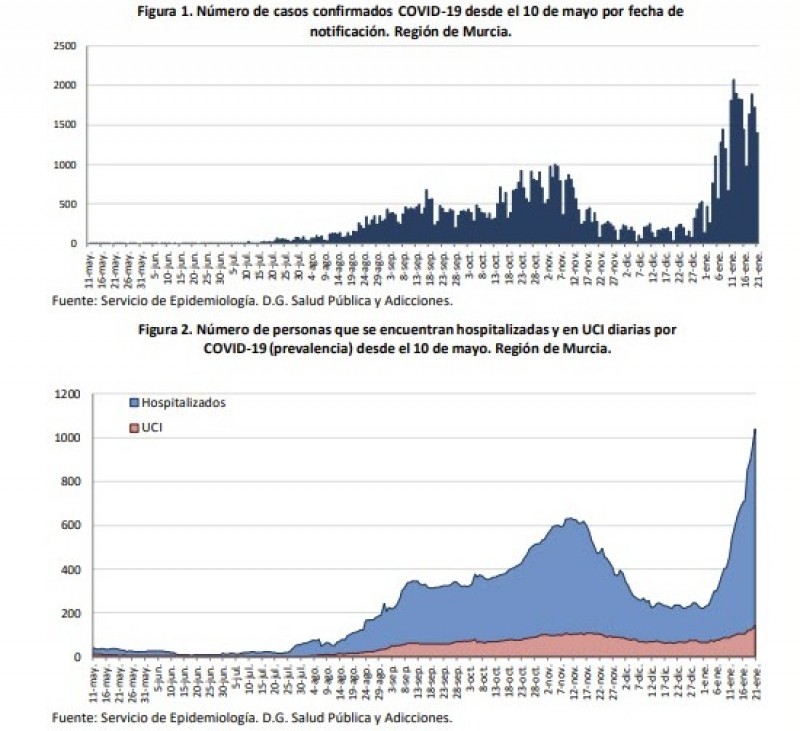
The coronavirus situation in Murcia is now critical and the region has been in second position for the highest number of cases per head of population in Spain virtually all week.
On Saturday morning the regional covid monitoring committee met in an emergency session and agreed to reorganise the allocation of staff and resources within the Murcian Health Service due to the overwhelming increase in patient numbers experienced this week.
From today, all non-urgent activities within the hospitals will be cancelled, staff will be re-organised, wards re-allocated and all resource re-directed to focus on coping with the current situation. The type of re-organisation mentioned in the press conference following the meeting today is changing the psychiatric ward of the Reina Sofía hospital to house covid patients.
On Monday the committee will meet again to analyse the situation and it is expected that measures in the region will once again be tightened; one measure being suggested today by the regional president is the suspension of all non-essential activities of any type at the weekends, in order to prevent the population moving.
As of Saturday, there were 1.057 patients with more severe cases of coronavirus in the region's hospitals and 156 in intensive care.
Last Friday the Murcia region had 14,416 active cases, a figure which has this week risen to 17,747.
Fatalities last Friday were 802, a figure which is now 905, a rise of 103 deaths during the last week. The highest number of deaths was the 19 reported on Friday, although the figure of 18 was the second highest ever on Saturday (today).
Total cases diagnosed were 75,902 and this figure is now 88,114, a rise of 12,212 new patients in a week.However, the number of new cases is starting to slow down and it's believed that the restrictions on movement are starting to take effect.
The Murcia AI accumulated incidence rate is 776 cases per 100,000 of population over 7 days and 1584 per 100,000 over 14 days, both extremely high levels.
The 14 day incidence rate is above 500 in every single municipality of the region except Librilla and Aledo, the highest being Moratalla with 3967 cases per 100,000 of population, which is ridiculously high!
So it's pretty grim, although the rate of new infections appears to be slowing down.
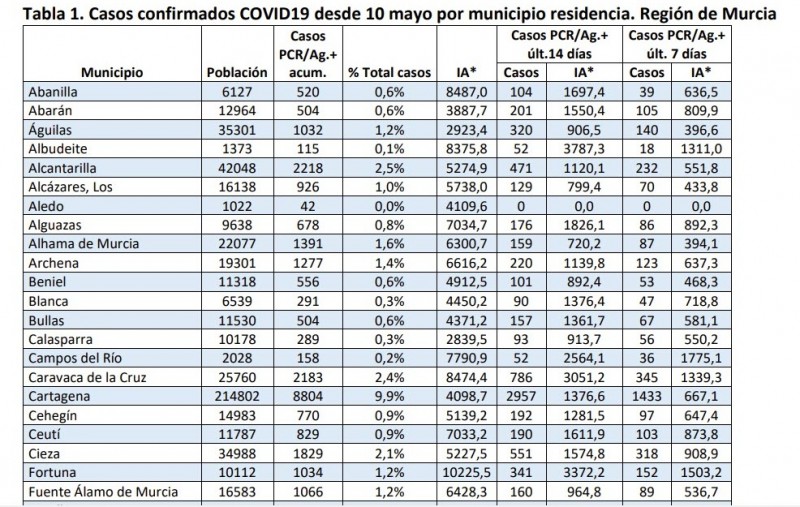
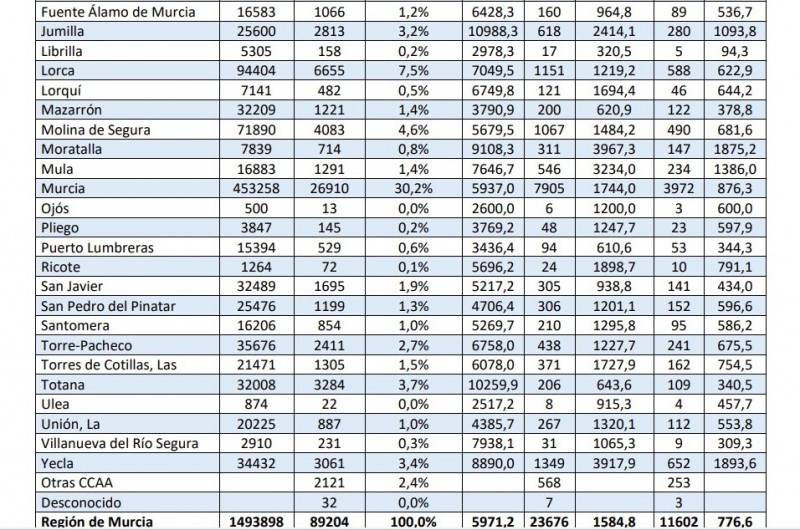
On Monday the Covid Monitoring Committee announced that bars and restaurants must close in every municipality except Aledo and Librilla, due to the high level of coronavirus infections.
In addition, all businesses considered non-essential, must close by 20:00 (8pm) in the evening.Only services such as supermarkets, pharmacies, petrol stations, veterinary centers, food delivery services, soup kitchens and wholesale trade suppliers will be permitted to continue trading. Businesses which offer a delivery service will be permitted to prepare deliveries behind locked doors.
All other businesses such as retailers, gyms and cinemas must be closed by eight o'clock.
The ban on all social contact continues this week and the restrictions are likely to be extended on Monday again as mentioned above.
The regional health authority announced that no visitors would be permitted for patients admitted to hospitals and that patients attending appointments should not bring companions when coming in to hospitals due to the increase in covid cases. Click to read
Yet people still continue to breach the restrictions: 144 sanctions issued by Cartagena police for non-compliance with covid regulations last weekend; many of the sanctions involved regulations which have been in place for several weeks such as not wearing a mask and breaching the curfew, although also included 6 restaurants which were serving groups of diners behind closed doors when they should have been closed altogether! Click to read
Immigration
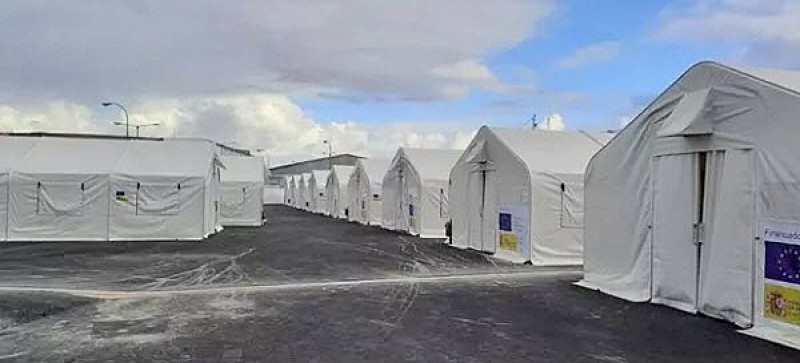
Police have arrested three people from Fuente Álamo who were part of the organised criminal operations which brought so many irregular migrants to the coasts of Murcia, Almería and Alicante this summer:
Members of the network operated on the border between the North African countries, facilitating the passage of people who were transferred and housed in homes located in Oran (Algeria), where they stayed until they could board a boat destined for the Almeria coast.
The network used a portfolio of skippers of 'patera taxi' type boats with which the coordinated entry through different parts of the eastern Almeria was planned.
The modus operandi used consisted of the arrival of groups of boats, coordinating time slots and places of disembarkation, in order to make it difficult for the Civil Guard to act at the time of the arrival of immigrants, as the boats were spread out across a wide area of coastline, and while the Guardia and coastguard were busy attending the arrival of one boat, others would arrive at a number of beaches almost simultaneously, making it impossible to intercept all of the vessels.
During the investigation, the Civil Guard agents learned that on September 16th a “wave”of boats with people from Oran (Algeria) was planned, which would enter Spain via the eastern coast of Almeria.
La Benemérita established a police vigilance operation that culminated in the arrest of three people residing in the Murcian town of Fuente Álamo, who had gone to the province of Almería and were waiting to receive the boats as they arrived in different parts of the coastline.
Both boats and the gang members waiting to receive them, were detained.
Yet in spite of the success of dismantling this gang, illegal migrants continue to enter Spain via Murcia Region.10 illegal immigrants reached the Playa de Levante in Águilas around seven in the morning on Monday and dispersed before police reached the beach. Some of them were intercepted on the Todosol urbanisation and others heading towards the urban area of the town.Three illegal migrants were reported to have drowned off the Almeria coast at the weekend when their boat overturned and 46 further migrants who were rescued off the Almería coast, also on Monday, were put into quarantine when three of their number tested positive for coronavirus.
Nationally, the problems continue to focus on the Canary Islands:
Unauthorized migrants transferred to field camps in the Canaries. Last year, 23,023 irregular migrants reached the islands, 756.8% more than in 2019, when the total was 2,687, according to data from the Ministry of the Interior.The national government of Spain now says that the first phase of a plan to move unauthorized migrants in the Canary Islands out of the hotels and other tourist accommodation where they have been temporarily housed is imminent, with the “Canarias 50” asylum centre initially set to house 442 people.
Over time it is anticipated that the capacity of the facility will be increased to 1,320 as more and more of those who arrived in the islands last year after travelling by boat from western Africa are transferred there, leaving tourist accommodation free for its habitual use when pandemic travel restrictions are eased.
Irregular migrants continue to target Canary Islands with triple the 2019 total already.Official figures published by Spain’s Ministry of the Interior show that during the first fortnight of this year 1,069 unauthorized migrants arrived on the beaches of the Canary Islands, well over three times the figure of 320 which was recorded during the equivalent period last year.
Meanwhile, despite the relatively unfavourable conditions at sea in recent weeks, more migrants are still arriving in the islands. On Tuesday morning it was reported that the maritime rescue services had intercepted a boat with 69 sub-saharans on board 35 miles south-east of Fuerteventura, bringing them ashore in Puerto de Gran Tarajal.
Other Murcia news:
Heavy snowfall in Spain brought sales boom for the salt pans of San Pedro del Pinatar.

Salt sales in San Pedro are reported to have been boosted by 50 per cent as extra supplies are purchased to help clear the roads of Madrid and other provinces further north, and so far approximately 7,000 tons have been delivered from the flats at the northern end of the Mar Menor. 90 per cent of these sales have been to Madrid and with demand still high the usual sales level of around 400 tons a day is being doubled. In a typical year around 80,000 tons of salt are produced in San Pedro del Pinatar.
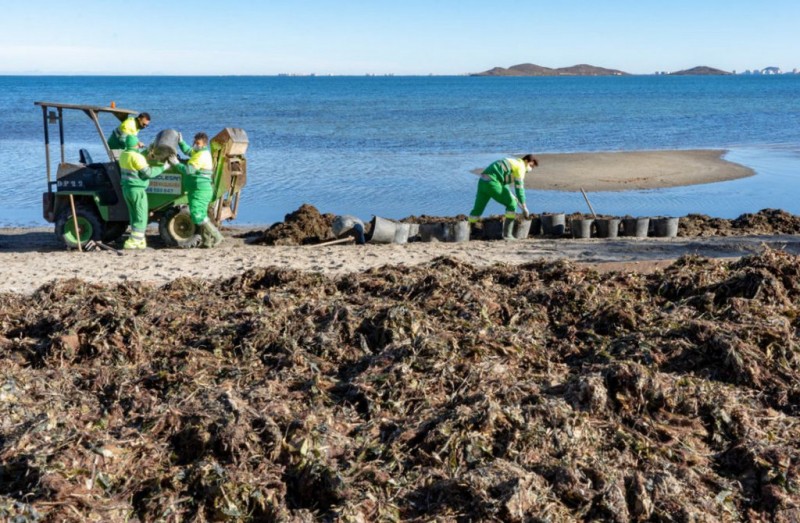
Sea grass and algae being cleared from Mar Menor beaches again.This winter has mercifully seen no repeat (as yet…) of the torrential storms which battered the Costa Cálida last year and carried large volumes of mud-laden water down into the lagoon, but in recent weeks large amounts of dead sea grass have been driven to the shores by the prevailing winds. If the vegetation is left there it will decompose and eventually cause the formation of the unpleasant mud which has been such a problem along the inland shore of the Mar Menor in recent years, hence the need to take action before this process begins.
The Town Hall teams are working this week mostly on the beaches of Punta Brava and Los Urrutias but are also scheduled to visit Los Nietos, Islas Menores and Playa Paraíso.
Property:
Spanish property market showing resilience to the pandemic.
Expectations in the Spanish property market for 2021 depend, like so much else at the moment, on how the situation develops regarding the pandemic which has turned the world on its head over the last 12 months, but a general consensus appears to be emerging among most analysts that for at least the first three quarters of the year both sales figures and market prices will continue the notable but far from catastrophic downward trends which have marked most of 2020.
Given the rise in unemployment and the generalized downturn in Spain’s economic fortunes, the outlook is perhaps not as bleak as might be expected. In general terms the demand for housing is falling as more and more people find themselves out of work or at risk of becoming unemployed, and young adults particularly are finding it difficult to climb onto the first rung of the property ladder, but on the other hand the changes in lifestyle brought about by current circumstances are leading to increased interest in certain types of home.
The rise in the number of people working from home and the domestic problems this can cause are reported by estate agents across the country to be causing many individuals to look for larger properties. Clearly the attraction of an extra room and/or outdoor space has been underlined by lockdowns and restrictions on travel over the last ten months (at the same time less densely populated areas are now more in demand than a year ago), and those who make the decision to seek an upgrade in terms of living space have access to record low interest rates on mortgage loans with the Euribor currently standing at approximately -0.5 per cent and unlikely to change significantly in the near future.
Detached properties are becoming more popular
One indication of this change in buyer preferences is that the latest monthly report published by Spain’s property registrars shows that 20.4 per cent of all purchases concerned detached homes, the highest proportion since records were first compiled.
In addition, vendors are aware of the fall in demand and many are becoming far more willing to flex their original asking prices, making it possible for purchasers to achieve reductions and finance their new homes at attractive interest rates, many of them opting for fixed rate terms.
In other words, while the restrictions on international travel are likely to continue to have a significant effect on the number of purchases made by non-Spaniards, which will undoubtedly impact on some coastal areas more than others, professionals within the sector expect a significant but not drastic decrease in sales figures in the first half of 2021, coupled with a similar fall in average market prices, but are optimistic that a recovery might begin by the autumn.
Property sales to non-Spaniards in Murcia down by 18 per cent in 2020.Pandemic travel restrictions take their toll as any Brexit effect is hidden by the coronavirus crisis. According to Spain’s notaries, while the number of sales completed during the third quarter of 2020 was actually 4.5 per cent higher than in the same period the year before, the country’s property registrars report that in the first half of last year the number of purchases made by non-Spaniards was down by 37.4 per cent in comparison with 2019, with even more significant falls noted in the cases of buyers from the UK, Ireland, Russia, China and Switzerland. This is likely to continue until such time as travel restrictions are phased out, although the market will not necessarily suffer too badly in the coastal areas where property sales to foreigners are generally most common: at present more and more Spaniards are searching for homes away from the large inland cities as working from home becomes more common and the attraction of extra living space, both indoor and outdoor, is increased by the lockdowns and restrictions of the last year.
The pandemic and Brexit affecting the Costa Cálida
This appears to be the case in the Region of Murcia, where the number of sales made by non-Spaniards last year showed a fall of 18 per cent up to the end of November. With just one month left to be added into the annual totals foreign nationals had acquired just over 2,500 homes in the Costa Cálida in 2020, well short of the 3,341 reported the year before, and this category accounted for approximately 18.3 per cent of all transactions, the lowest proportion in the last five years.
Adding to the uncertainty regarding Covid, of course, are the doubts over the long-term effect of Brexit in terms of the ability of people from the UK – by far the most important source of non-Spanish buyers in Murcia – to purchase and enjoy holiday or retirement homes in the Costa Cálida. However, promoters and estate agents report continued interest from the British, although the number of sales being completed has dropped off sharply since travel restrictions were re-introduced after the summer.
Most likely it will not be possible to evaluate the effect of Brexit until the pandemic restrictions are finally lifted, and the issues created for buyers by the departure of the UK from the EU have been ironed out, but it is worth recalling that in 2019 UK nationals accounted for over a third of all purchases made by non-Spaniards in Murcia. The next highest proportions were those attributed to Morocco (19.6 per cent) and Belgium (7.4 per cent).
Since the actual departure of the UK from the EU all sorts of details relating to property transactions including the change in taxation levels for those owning properties in Spain but living elsewhere, have come to light and the reality of following the bureaucratic procedures required to make a move out to Spain and acquire residency has promoted a significant level of queries on social media as those who have always dreamed of making a permanent move abroad re-evaluate their options based on the practical implications of the changes brought about by Brexit.
With British nationals currently unable to fly to Spain to view properties due to coronavirus restrictions it is logical that there should be a lower level of actual sales to British nationals at the beginning of 2021, and that during the year market conditions will be far from “normal”.
Thank you for your support.
